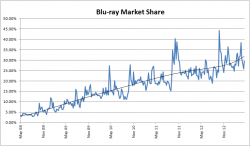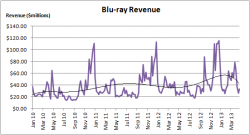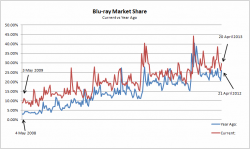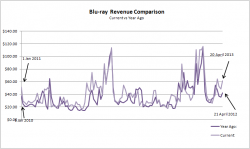Blu-ray: The State of Play – May 2013
Welcome to another edition of our annual Blu-ray sales analysis, even if this one is slightly late. It’s been more of the same for Blu-ray since the last issue in this series here, and with increasing competition from streaming, and potential future competition from 4K, it’s worth having a look at where Blu-ray is.
The data used in this analysis derives from our weekly updates, based on figures released by Home Media Magazine. Some of the historical figures you’ll see have also been adjusted, due to slight tweaking of the metrics used by HMM to create these sets of data, although the changes have been very subtle and does not change the bigger picture in any way.
The first set of graphs show Blu-ray market share (Blu-ray and combo market share as a percentage of all disc sales) through the five year period that I have tracked them, with the release milestones pointed out.
As the graph is getting perhaps a bit too wide, here’s a condensed version that allows you to see Blu-ray’s market share rise more clearly.
We’ve had our fair share of milestone releases in the 52 week period since the last “State of Play” feature. While there’s no Star Wars this time around, we do have The Avengers and The Hobbit, the former responsible for the peak in the graphs above. The new market share record is now 44.23%, beating the 40.22% set by the release of The Lion King back in 2012. The up and down nature of the weekly results show that market share, like revenue, is very much release dependent. A good “A-lister” this week or a Blu-ray exclusive can get market share and revenue rising fast, but a slow week, and it goes down again. But the rising trend is clear, especially in the second graph above. The trendline just breaks above the 30% mark at the end of April 2013, and that’s probably a fair reflection of where Blu-ray market share is, or will be soon enough.
For this latest 52 week period ending 20th April 2013, the average weekly Blu-ray market share figure was 27.57%. This compares to 23.67% from the previous 52 week period. This is in-line with the 4-6% annual increase in market share that Blu-ray has experienced since inception.
It’s worth noting that Blu-ray’s rising market share has as much to do with DVD’s decline as it has to do with actual rise in Blu-ray sales, probably more so. The rise in spending in digital streaming and downloading is one of the major factors in the decline of DVD sales, in addition to the rising popularity of Blu-ray.
For Blu-ray revenue, the trend is less clear, although I have less data in this regard compared to market share (just under three and a half year’s worth), other than that there is definitely a seasonal trend within the overall trend, peaking unsurprisingly during the holidays sales period.
Analyzing the peaks, we’re seeing a gradual rise from year to year, and the trendline reflects this as well. Again, you can see that revenue is both release dependent (when the revenue peaks line up with the market share peaks) and seasonal dependent (when revenue peaks does not line up with market share peaks). Taking averages of these weekly results, this latest 52 week period yielded an average weekly revenue figure of $44.84 million. This compares with $39.44m and $34.05m from the last two 52 week periods, producing a trend that seems to indicate a $5 million rise in average weekly revenue every year.
The last two set of graphs shows a comparison of weekly market share figures with the same figure from a year ago, and the same comparison but with revenue figures.
These two graphs are less indicative than the other graphs, but they’re interesting in that they show the seasonal effect in full force – note that the peaks and troughs occur roughly at the same time every year, for both market share and revenue. The more noticeable gap between the year-on-year market share comparison, and the less noticeable gap between the revenue version of the same comparison, again highlights that other factors exists (ie. decline of DVD sales) when taking into account market share.
In conclusion, it’s been another steady year of growth for Blu-ray. It looks as if it will take a while for Blu-ray to become the dominant disc format (dominant as in more than 50% market share on average), but on the whole, the format looks in healthy growth.





June 10th, 2013 at 1:36 am
That’s nice but really I have invested nothing into Blu Ray as it was obsolete before the patent trolls and attorneys allowed it out of the engineers shop. As I remember the sad day the beta player died and that major expense of pre recorded media became landfill all to soon followed by its sister vhs. And the massive number of factory recorded tapes that went into the putrid pits with it. Having held back on DVD purchases I have a much less tedious trip to the trash. And when Blu Ray dies I will merely note its passing. My prediction and warning to previous mentioned patent trolls and developers. Make it better, cheaper and it will sell. Keep screwing around with better ways to screw the buyer with DRM and I guarantee you will sleep with the brontosauri.
August 8th, 2013 at 9:59 pm
You’re dumb.
August 9th, 2013 at 2:44 am
Oh nameless one, only time will tell who speaks with wit and who with a less desirable format.
September 10th, 2013 at 8:27 am
This sorta seems like propaganda. I don’t really believe the numbers honestly. At least in my demographic, there’s not a single person I know that cares at all about BluRay. Maybe people are buying them in the rural communities where the internet is poor. But where I’m from, Blu-Ray is already dead, and anyone who is anyone knows that it will be completely taken over by digital distribution forms in the very near future.
September 12th, 2013 at 10:21 pm
If you look into the numbers, at the steady decline of DVD sales, only some of this is accounted for by the rise in Blu-ray sales. The rise in digital distribution and streaming, I think, is the actual main driving force behind the drop in DVD sales.
Blu-ray is aimed at a slightly different demographic compared to digital distribution, at home theater nerds like me that likes to collect (physical) movies, and want the absolutely best AV quality. But even I have a Netflix account and it accounts for 90% of my viewing these days. When Netflix quality and people’s connection speeds can improve to the point where it allows for the viewing of “almost Blu-ray quality” content (assuming 4K hasn’t yet taken off), we might start to see digital eat into the Blu-ray market share as well.
This news article might be of interest too: http://www.digital-digest.com/news-63725-Blu-ray-and-Digital-Rise-To-Offset-DVDs-Decline.html
October 6th, 2013 at 10:31 pm
Bluray is the best format we have ever had and for Europe the first one that in terms of official area releases runs films at their native speed. Streaming movies is for the same idiots who use MP3 and iTunes.
March 4th, 2014 at 10:35 pm
I believe DVD will still go strong. Walmart has a TON of DVDs for cheaper price then Blu-Ray! I rather pay those $5 DVDs then then spending $30 on a BR discs. I also buy CDs when they are $5 also. I sometimes spend $30 per week on media products. I don’t download online. So I just upload my music into itunes and into my ipod. Most of the time I will use my CD player and BR player to upscale my DVDs. I don’t have many BR maybe like 10 out of 100 DVDs I own. Also price is cheaper for CD and DVD now.